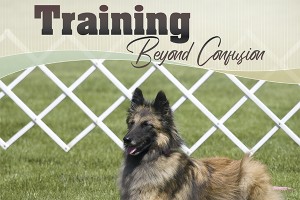Training Beyond Confusion
Click here to read the complete article
116 – November/December, 2024
 By William Given
By William Given
When training a dog for Rally, Obedience or Tracking, there will always be times when it does not respond in quite the manner we believe it should have. The same will be true for dogs being trained for competition in any of the AKC’s performance events. It is, however, possible that the dog is being willfully disobedient, but it is much more probable that it is simply unsure of what it should be doing. In simple terms, the dog is confused. Any time we have a dog, a trainer and a new learning process, it is likely there will be some degree of confusion. Confusion is a part of the learning process, but it’s something we would like to keep to a minimum, and we understand that we will have to work through it.
Levels of Confusion
The important thing to know about confusion is simply recognizing it for what it is and then doing what we can to minimize and eliminate it. How do we know for sure that what our dog is experiencing is confusion and not just stubbornness or disobedience? We have to be able to read our dog’s attitude and body language. A dog that is confused will show it. Simple confusion will present with small changes in its body language; drooping or a pinning back of the ears, tucking its tail instead of carrying it normally or dropping its shoulders. We might see our dog acting more tentative or less eager than normal, stopping and looking at us or maybe slightly tilting its head to the side while looking at us for guidance.
Extreme confusion can manifest itself as fear. Here we might observe a dog demonstrating confusion by crouching, crawling around and, if the fear is great enough, it might bite or bolt. A defiant dog will in likelihood ignore us completely while doing as it pleases. The dog may have its head, ears and tail up showing us it is confident in its actions. A dog that is confused will not.
Confusion means a dog is uncertain and whether it is unsure of what has been asked to do or how we have asked the dog to do it, a remedy must be found. In most training situations, the confusion is the result of an unclear message from the handler. This is commonly the result of not giving the dog enough information to work with; we have not laid a solid foundation with earlier training or we have rushed training to meet our needs and not that of the dog. So, we have probably not provided it with the tools necessary to do all we are asking. All training is based on repetition and association. Our impatience is generally what leads to confusion.
Avoiding Confusion
Click here to read the complete article
116 – November/December, 2024

Short URL: https://caninechronicle.com/?p=309696
Comments are closed











